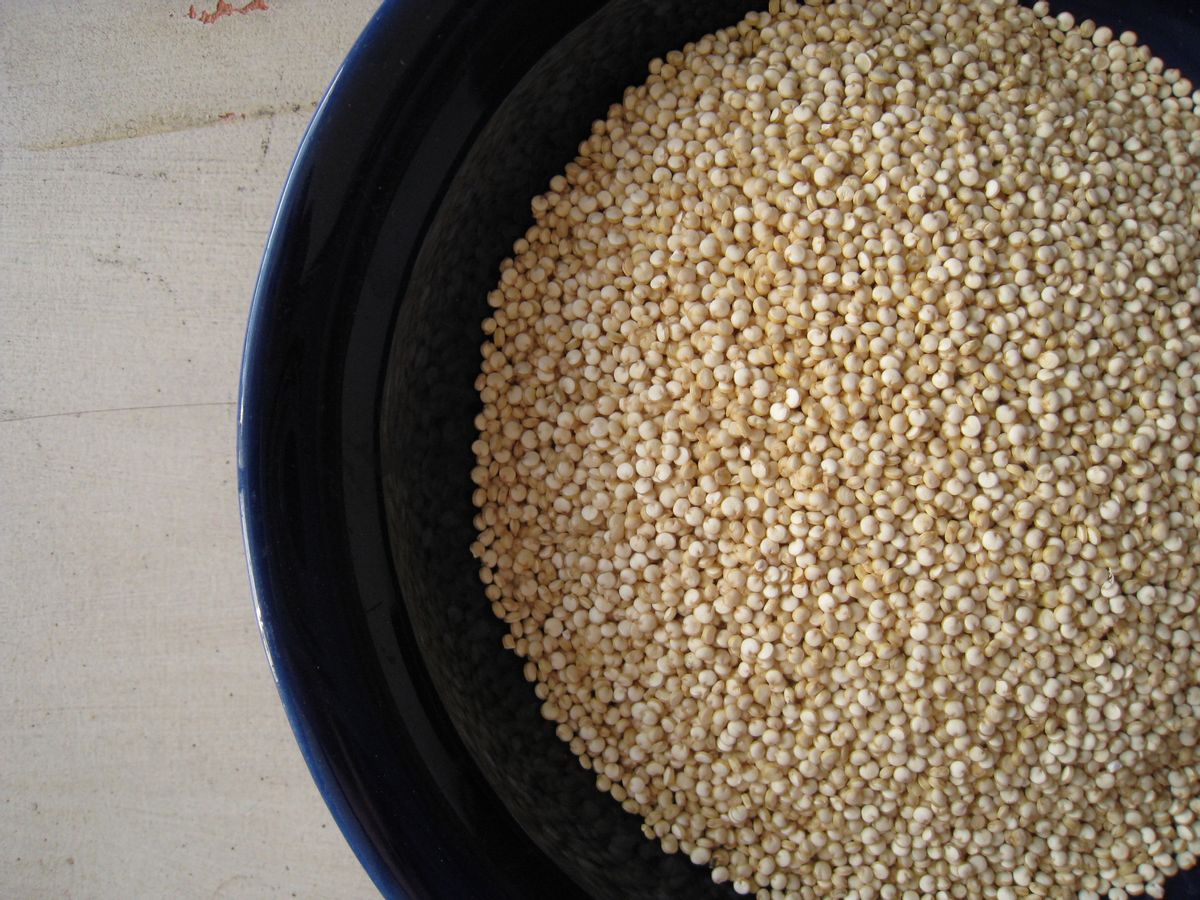Quinoa is the kind of food that I didn't think was food. Sure, I mean, technically it fits the bill: you can put it in your pie hole and it has calories and such. But every mention of it being The Incan Supergrain or the Miracle Food or the Mother Food of the Ancients made me inch away like I was getting stared down by an angry bottle of patchouli. Look, I'm thrilled it’s one of the Earth Mother's only vegetable-based complete proteins, but when you start trying to sell food to me like that, I'm calling you a dirty hippie and running away. I ate some carob once. I'm not going back down that road.
But I did some tune-changing when a chef of mine in culinary school made me try some. It was delicious! (One case where fear and an iron fist is more effective than gentle suggestion.) The odd, musty, ginseng-like smell of raw quinoa gave way to a lovely nutty, grassy flavor when cooked, with wonderful texture that pops ever so slightly between the teeth. (It didn't hurt that we served it with a coconut milk-drenched shrimp stew, but still…) The key, as always with any grain, is to cook it properly, and I'll show you how below.
The reason quinoa is on my mind today, though, is because of a wild story over on the Atlantic Food Channel on the poor Colorado trio who first tried to bring quinoa to the U.S. market from South America in the 80's. It's a spooky tale of curses, murder, and shamanistic hoo-doo. Really. You won't believe the metaphysical wrath that befalls the dudes who just wanted to sell a few pounds of this stuff while standing in a Boulder health food store (which, frankly, should have been karmic punishment enough). Check it:
The shaman removed the curse, and Gorad's headaches went away. Regarding Cusack, Gorad had never put much stock in the conspiracy theories surrounding his death. He believes somebody, maybe a hunter, fired off a gun, and that the bullet was guided by the same unseen force that caused his headaches. He notes that the indigenous populations who grew most of the quinoa have had a history of bad relations with outsiders ever since the Spanish came in the 16th century. The notion that now they were coming for the mother grain may have been too much to bear.
Happily, quinoa is now widely available with little bloodshed. If you're like my ladyfriend or Salon's own Boss Lady Joan Walsh (who said, when I proposed this story, "I can see someone getting killed for that. Quinoa is the most disgusting thing that's ever been served."), you're not really thrilled. But make it pilaf-style, and I'd bet someone else's life you'll love it.
Quinoa pilaf
Serves 4 - 6 as a side
2 C quinoa
3 C water (or stock, if you want to get serious)
Olive oil, or any fat of your choosing
salt and pepper
- Preheat your oven to 325. This is also what I do when making rice. Yes, I'm Chinese. No, I can't make rice on the stovetop. I used to be filled with shame about this, but then I realized that every Chinese home I've ever been in has a plug-in rice cooker, so now I feel much less bad about it.
- Put a heavy 2-qt (or thereabouts) saucepan with a tight-fitting lid over high heat. Coat the bottom of the pan with oil. Be generous with it: think of the poor cursed quinoa Quixotes. When the fat is hot enough to shimmer, add the quinoa and stir, coating all the grains in oil.
- Toast, stirring. The sound in the pot should be a bit squeaky. When the smell is a little like toasting nuts, a little like popcorn, and it starts to sound like a sizzle, add the water or stock; the pot should be hot enough for it to boil instantly. Keep cooking it over high heat until it maintains a boil. Add a few pinches of salt, give it a quick stir, put the lid on, and drop it in the oven.
- 16 minutes later (13 for rice), pull it out and uncover. The quinoa should be cooked, throwing steam but with no liquid in the grains. (If it's still wet, put it back in the oven for a few more minutes.) Gently stir to fluff the grains, letting it steam off to dry for a few minutes. Taste it. Doesn't it taste like brown rice's cooler cousin? Does it pop in your teeth? Then you've done it right. Season with salt and pepper, stir, and serve.
Note: This is also the method for perfect basic long-grained white rice pilaf. If you want to get fancy, toast some aromatics (garlic, onion, spices, etc.), in the oil before adding the quinoa or rice. Also note that if you increase the quantities of this recipe, it might take more time in the oven, but check it at the recommended times anyway.
To serve: Serve this with anything you would eat with rice. Though there isn't quite the same level of starch in quinoa to pick up very loose sauces, it's still great, and richer and creamy sauces work especially beautifully. One thing I like to do is spread the cooked quinoa out to let it steam off and cool and make a salad with it: fold in raw and roasted vegetables, nuts, grated parmigiano cheese, and dress it with vinegar or lemon juice and nice olive oil.



Shares